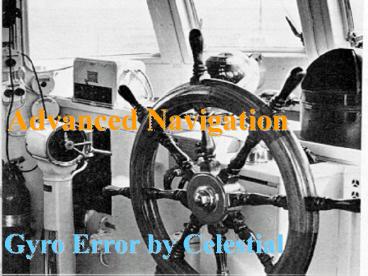Advanced Navigation - PowerPoint PPT Presentation
1 / 14
Title:
Advanced Navigation
Description:
gyro error and the periodicity in which it is. determined. ... the directions indicated by the gyro compass, and the respective true directions. ... – PowerPoint PPT presentation
Number of Views:116
Avg rating:3.0/5.0
Title: Advanced Navigation
1
Advanced Navigation
Gyro Error by Celestial
2
Objectives
1. Understand the importance of determining
gyro error and the periodicity in which it is
determined. 2. Review the methods of
determining gyro error when piloting.
3
Objectives
3. Demonstrate the method of determining gyro
error by using / observing the sun. 4.
Demonstrate the method of determining gyro
error by using / observing Polaris. 5. Discuss
the advantages and limitations of using the
amplitude equation to determine gyro error.
4
Objectives
6. Discuss the best time to observe a body for
the purpose of obtaining an amplitude to
determine gyro error.
5
Review
Gyro error is the difference between the
directions indicated by the gyro compass, and the
respective true directions.
West Error
East Error
If the ship were on a course of 000 pgc, it would
be pointed left (west) of true North.
If the ship were on a course of 000 pgc, it would
be pointed right (east) of true North.
6
Review
If Gyro is Least, error is East. If Gyro is
Best, error is West. Gyro bearing Easterly
error True bearing G E
T
7
Methods of determing Gyro Error
- The easiest way of determining gyro error is to
compare the compass bearing to an object with its
known (true) bearing. Three ways of doing this
celestially are - Exact Azimuth
- Amplitude
- Polaris
Ideally, the observed body will have an altitude
of less than 30 degrees.
8
Amplitude Method
The amplitude is defined as the horizontal
angular distance between the body and the prime
vertical.
The amplitude method calculates this angle and
converts it to a true azimuth, which can be
compared to the bodys gyro bearing.
This method can be used when the observed body is
rising or setting, as long as its declination
does not exceed 24 degrees.
9
Amplitude Method
Advantages 1. The simplicity of taking an
azimuth while the body is rising or setting. 2.
No strip form required.
Limitations this method can only be used when
the body is rising or setting, defined as 2/3 of
a solar diameter above the horizon for the sun,
and one solar diameter for everything else.
10
Amplitude Method
To determine the amplitude angle (A) use the
following formula A arcsin (sin Dec / cos Lat)
The result, A, will be expressed with a letter
prefix and suffix. E or W will precede the
angle, depending on whether the body is rising
(East) or setting (West). The suffix will be N
if the body has a north declination, or S if
its declination is south.
11
Amplitude Method
To convert amplitude angle to a true azimuth, use
the following formulas
Position of Body True Azimuth North of East 090
- A South of East 090 A North of West 270
A South of West 270 - A
12
Polaris
Polaris, called the north star, is always within
2 degrees of true north. Calculating the true
azimuth of Polaris is part of the strip form.
Compare this azimuth to the gyro bearing to the
star.
13
Questions?
14
Compliments of Curtis Senior High School NJROTC































